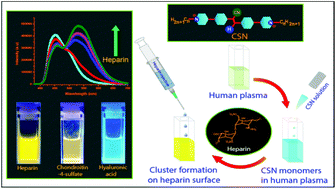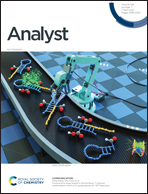Highly sensitive and ratiometric luminescence sensing of heparin through templated cyanostilbene assemblies†
Abstract
The assembly of organic dyes on bio-molecular templates is an attractive strategy for the creation of bio-materials with intriguing optical properties. This principle is exploited here for the detection of polyanion heparin, a known anticoagulant, by employing di-cationic cyanostilbene derivatives with inherent aggregation induced emission (AIE) features. The cyanostilbene derivatives exhibited weak cyan-blue monomeric emissions in solutions but upon electrostatic co-assembly with heparin, formed highly luminescent clusters on the polyanion surface. The cyanostilbene chromophores in the clusters exhibited greenish-yellow excimer emissions with remarkably longer life-times (up to 70-fold) and higher quantum yields (up to 85-fold) compared to their aqueous solutions. This led to heparin detection in aqueous buffer in low nanomolar concentrations. Additionally, and more importantly, a ratiometric detection of heparin was achieved in highly competitive media such as 50% human serum and 60% human plasma in medically relevant concentrations.



 Please wait while we load your content...
Please wait while we load your content...